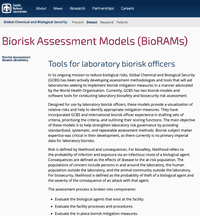Biorisk Assessment Models (BioRAMs)
[BioRAMs]
Sandia has two biorisk models and software tools for conducting laboratory biosafety and biosecurity risk assessment. These models provide a visualization of relative risks and help to identify appropriate mitigation measures. The main objective of these models is to help strengthen laboratory risk governance by providing standardized, systematic, and repeatable assessment methods.
SUMMARY
The Biorisk Assessment Models (BioRAMs) are two tools created for conducting biosafety and biosecurity assessments in laboratories working with biological pathogens. The tools were designed for laboratory biorisk officers from around the world to help strengthen lab risk governance in the international community, according to WHO supported standards. BioRAMs helps identify and prioritize biorisks, and takes into account lab-specific features such as properties of the particular biological agents onsite, existing lab security features, current mitigation measures, and the likelihood of malicious activity for the particular pathogens in the the lab. Additionally, the scalable systems report includes, "A risk Assessment Methodology for Physical Security" in order to add important context for a framework about estimating risk and security needs at a facility.
BioRAMs is one of several tools supported by the Global Chemical and Biological Security (GCBS) Program at Sandia National Labs. The tool was created in 2010, in collaboration with biosafety and infectious disease experts from around the world. Access to BioRAMs is restricted, email the GCBS team at gcbs@sandia.gov for access information. BioRAMs can be downloaded as a software tool and is available in English. This resource was recommended by many of the experts interviewed for this library.


..png)
